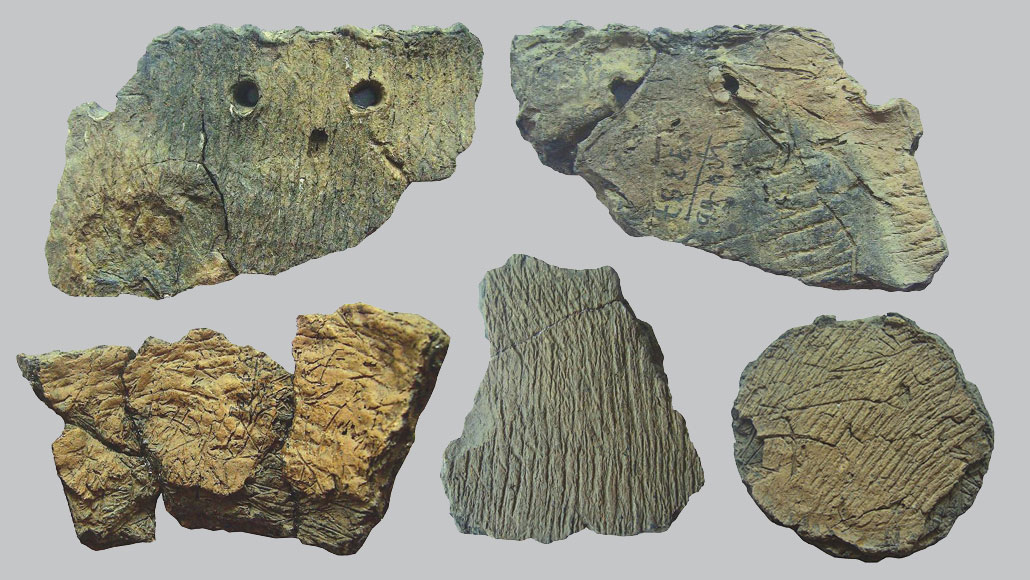Food residues offer a taste of pottery’s diverse origins in East Asia
Some hunter-gathers used pots to cook fish, while others served up animals such as sheep

Pieces of cooking pots (shown) made by one ancient East Asian hunter-gatherer group contain chemical residues of fish such as salmon. Those people invented pottery independently of other hunter-gatherers in the region, scientists say.
Yanshina Oksana
Pottery making may not have emerged in one Big Bang–like event. Instead, it was more like a cluster of ceramic eruptions among ancient East Asian hunter-gatherer groups as the last ice age waned, a new study suggests.
East Asian hunter-gatherer populations living about 700 kilometers apart made and used cooking pots in contrasting ways between around 16,200 and 10,200 years ago, says a team led by Shinya Shoda, an archaeologist currently based at the University of York in England. Each of those groups probably invented its own distinctive pottery-making techniques, the scientists suspect.
“Our results indicate that there was greater variability in the development and use of early pottery than has been appreciated,” Shoda says.
Pieces of ceramic cooking pots from one group preserved chemical markers of fish, including salmon, Shoda’s group reports in the Feb. 1 Quaternary Science Reviews. Early pottery making by those hunter-gatherers accompanied seasonal harvests of migrating fish, the researchers say.
Fatty acids extracted from remnants of a second group’s pots came from hoofed animals such as sheep or goats. Those vessels were used to render grease from animals’ bones, the team suggests.
Each group appears to have had its own pottery-making style. Members of the Osipovka culture, who lived along the Lower Amur River in what’s now the Russian Far East, crafted cone-shaped vessels with flat bottoms and thick walls. Clay paste was mixed with gravel and other material. Inside and sometimes outside surfaces of pots were scraped with tools like combs.
At sites of the Gromatukha culture, situated on the banks of the Amur River and its tributaries northwest of Osipovka sites, researchers found slightly curved pots that rested on either flat or round bases. Clay was typically mixed with grass, especially in the oldest pots. Cord marks and zigzag patterns cover many vessels.
Other researchers have reported that the earliest known pottery, from Xianrendong Cave in southern China, dates to roughly 20,000 years ago (SN: 6/28/12). Although there has been debate about the accuracy of that age estimate, “it is certain that the world’s oldest pottery gradually emerged in East and Northeast Asia from 20,000 to 10,000 years ago,” says archaeologist Hiroyuki Sato of the University of Tokyo. That timing corresponds with the end of the Pleistocene Ice Age, which lasted from roughly 2.6 million to 11,700 years ago.
Chemical residue findings for the Gromatukha pottery challenge a currently popular view among researchers that the earliest pottery was used only for cooking fish and shellfish, says Sato, who did not participate in the new study. Shoda’s group provides the first chemical evidence of land animals being cooked in some of the world’s earliest clay pots.
The researchers analyzed chemical residues on 23 pot shards from three Osipovka sites and five pot shards from one Gromatukha site. Signs of fish having been cooked in Osipovka pots came as no surprise, Shoda says. More than 100 freshwater fish species currently inhabit the Amur River, as well as fish such as salmon that return to the river to spawn from late spring to early fall.
Past excavations of at least 15 sites indicate that Osipovka pottery was produced in large quantities only after around 13,700 years ago. Osipovka people probably started out using ceramic pots to prepare fish for special events or ceremonies, not daily meals, the researchers speculate.
Only three Gromatukha sites have been excavated, so less is known about pottery making in that culture. But chemical residues indicate that the Gromatukha menu leaned heavily on land animals, Shoda says.
In a 2016 paper, Shoda and his colleagues reported chemical evidence of what they now regard as a third, comparably old pottery-making tradition that arose in Japan. Distinctive pots of Japan’s Jōmon culture, unearthed at one well-preserved site, were used to cook fish and mollusks from around 14,000 years ago until as late as 5,000 years ago, the scientists found.







